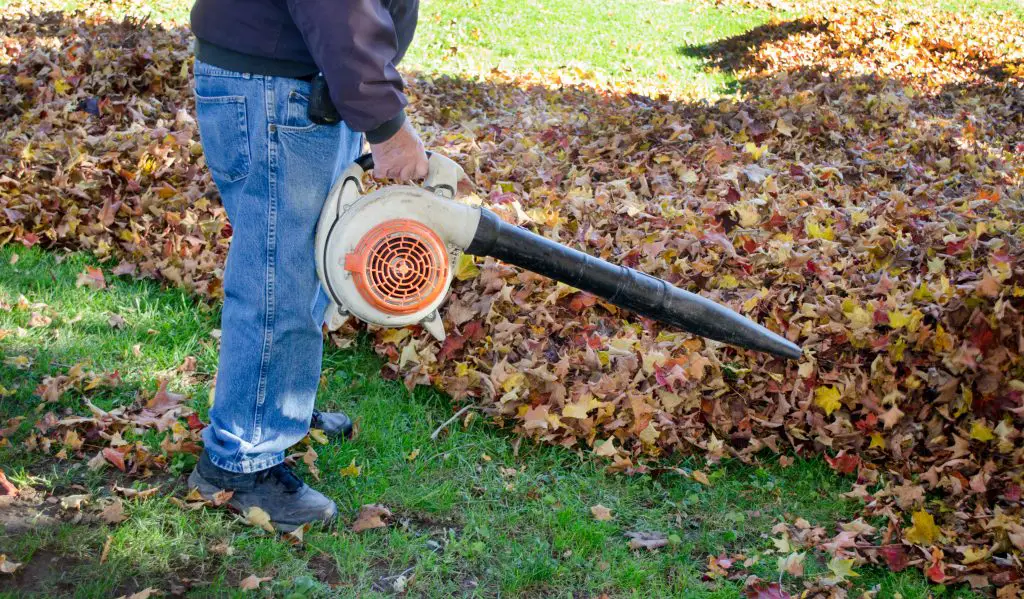Nobody really takes delight in having to rake their lawns or any of the dozen different yard tasks that require continually being hunched over to deal with whatever happens to be on the ground.

Because of this, many people choose to go down the route of purchasing a leaf blower.
Not everybody’s lawn and associated yard work tasks are at the same level, so there are dozens of different types of leaf blowers and how they are all rated can vary drastically.
We’re going to break down many items you’ll see on the box of a leaf blower and how to interpret them, as well as explain the different types of leaf blowers available to consumers as of today.
First off, Some Leafblower Terminology:
CFM: Cubic Feet Per Minute
A common way to quantify a leaf blower’s power is with CFM. This stands for cubic feet per minute. A leaf blower with a CFM of 600 can displace 600 cubic feet of air in a single minute.
Meanwhile, cubic feet is a measurement of volume, ( length x width x height ) of a certain amount of space. For instance, a patch of leaves one foot high, twenty feet long, and thirty feet wide could theoretically be cleared in a single minute using a leaf blower with a CFM of 600.
Since 1 x 20 x 30 = 600, we can see that the math checks out.
MPH: Miles Per Hour
The MPH rating of any leaf blower refers to the speed at which air is being shot out of the leaf blower.
CFM and MPH are somewhat related, but some leaf blowers can have a lower MPH rating, but a significantly higher CFM rating based on the rake head (end) of the blower.
For this reason, it should be noted that MPH isn’t the be-all-end-all of power and CFM needs to be factored in with the MPH rating.
Engine CC’s (capacity)
The next measurement refers to how powerful the engine within the leaf blower is, and this is measured in CCs. It refers to the engine cylinder volume in cubic centimeters.
The number of pistons and their individual volume covered by each stroke are added together to get the number of CCs.
A higher CC means more power is available since a higher mixture of fuel and air is available for combustion. This increase in power is correlated with a decrease in fuel economy.
Noise Level
A leaf blower’s noise level is commonly measured in decibels and is essential when factoring in how loud you’re willing to tolerate your leaf blower, as well as considering how much noise pollution is acceptable to add to your neighborhood during its use.
The decibel scale isn’t linear.
By that, we mean 60 dB isn’t twice as loud as 30 dB, but instead about six times as loud.
Any leaf blower above 75 dB should be used only with adequate hearing protection.
The quietest leaf blowers on the market are in the realm of about 65 dB, so it’s safe to say you should probably pick up hearing protection when purchasing just about any leaf blower.
Weight
This is the last attribute we’ll be covering, and it’s the simplest one to figure out and deal with.
The weight of the leaf blower is simply how many pounds or kilograms it weighs.
Since you’re going to be the one using the leaf blower, pick a leaf blower that’s heavy enough to have enough power to get the job done, but not so heavy that you’ll end up hating having to use it.
Types of Leaf Blowers
There are three main types of leaf blowers:
Handheld
A handheld leaf blower is the smallest of all leaf blower varieties and can be easily operated using only one hand. They don’t take up a lot of space and are reasonably light.
The kinds of jobs well-suited to handheld leaf blowers are small jobs like clearing a driveway or minor touch-ups.
Backpack
Backpack blowers allow the user to strap the leaf blower on their back and operate the blowing tube with one of their hands.
Typically, backpack leaf blowers are of higher strength than handheld and are therefore bigger. They are too big to handle comfortably with only the hands, so the blower itself is put on straps so it can be easily carried on the back. Backpack leaf blowers are excellent for clearing entire lawns or blowing away all of the snow on your car in the morning.
Essentially, if you routinely would need to use a leaf blower for over an hour at a time, it’s worth considering a backpack leaf blower.
Blower Trimmer Combo
There is also a very useful combination tool available from some manufacturers that combine two and sometimes three functions within one unit, known as a trimmer blower combo.
These are more suited to smaller and medium-sized yards and gardens.
Walk-Behind
The last variety of leaf blowers is the walk-behind leaf blower, and it’s the choice of professional groundskeepers or other people with massive areas of land like farmers.
The blower is on wheels and is pushed in a way that’s much like how a lawnmower operates. These blowers have much less mobility and precision than their smaller cousins but are essential for massive industrial or commercial level jobs.
Types of Leaf Blower Power
Battery Powered
A battery-powered leaf blower uses a rechargeable battery to power the engine. Sometimes, these batteries are cross-compatible with other tools from the same manufacturer and are particularly user-friendly.
They are easy to use, making them great for newbies, but have the caveat of limited run time before the battery has to be recharged.
Corded Electric
Corded leaf blowers use electricity much like battery-powered leaf blowers, except the power will never run out.
They tend to be more powerful than the battery-powered since there are limitations to batteries, but you’re limited by how much cord you have and the cord can be a nuisance if it gets in the way often.
Gasoline Powered
Large gas-powered leaf blowers tend to be the most powerful, but they require much more know-how than their electric counterparts. Proper oil: gas ratio must be maintained to ensure the proper functioning of the leaf blower.
Gas leaf blowers are extremely powerful and are noted for their long run times, but can be confusing for the first-timer and excessively loud. The volatile nature of gas prices also affects the convenience factor of having a gas leaf blower.
Conclusion
There you have it. That’s just about everything you’ll ever need to know about this lawn care tool. They can prove extremely helpful during the summer and autumn months when there’s debris stopping your yard from looking its absolute best. Instead of having to preen and prune manually, letting a leaf blower clean everything up through raw force can be satisfying, quick, and easy.

